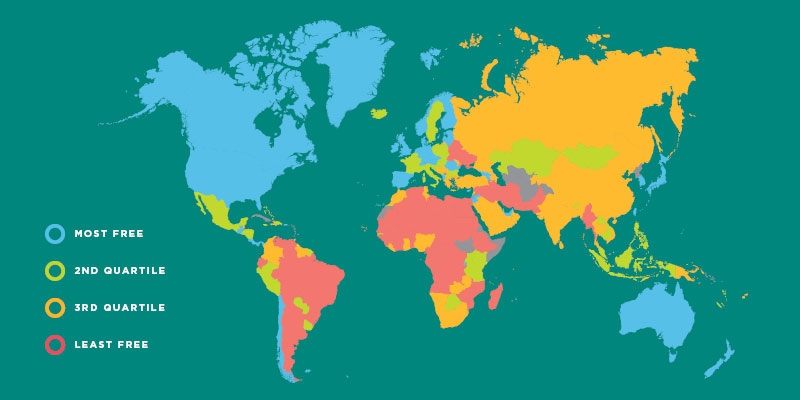Economic Freedom of the World: 2018 Annual Report

The index published in Economic Freedom of the World measures the degree to which the policies and institutions of countries are supportive of economic freedom. The cornerstones of economic freedom are personal choice, voluntary exchange, freedom to enter markets and compete, and security of the person and privately owned property. Forty-two data points are used to construct a summary index and to measure the degree of economic freedom in five broad areas.
- Area 1: Size of Government - As government spending, taxation, and the size of government-controlled enterprises increase, government decision-making is substituted for individual choice and economic freedom is reduced.
- Area 2: Legal System and Property Rights - Protection of persons and their rightfully acquired property is a central element of both economic freedom and civil society. Indeed, it is the most important function of government.
- Area 3: Sound Money - Inflation erodes the value of rightfully earned wages and savings. Sound money is thus essential to protect property rights. When inflation is not only high but also volatile, it becomes difficult for individuals to plan for the future and thus use economic freedom effectively.
- Area 4: Freedom to Trade Internationally - Freedom to exchange—in its broadest sense, buying, selling, making contracts, and so on—is essential to economic freedom, which is reduced when freedom to exchange does not include businesses and individuals in other nations.
- Area 5: Regulation - Governments not only use a number of tools to limit the right to exchange internationally, they may also develop onerous regulations that limit the right to exchange, gain credit, hire or work for whom you wish, or freely operate your business.
Gender Disparity Index
The index published in Economic Freedom of the World now includes an adjustment for gender disparity to take into account the fact that in many nations women are not legally accorded the same level of economic freedom as men. The Gender Disparity Index and its use to make the adjustment is described in Chapter 3: Adjusting for Gender Disparity in Economic Freedom and Why It Matters, pp. 189–211 in last year’s report.
Related research
Since our first publication in 1996, numerous studies have used the data published in Economic Freedom of the World to examine the impact of economic freedom on investment, economic growth, income levels, and poverty rates. Virtually without exception, these studies have found that countries with institutions and policies more consistent with economic freedom have higher investment rates, more rapid economic growth, higher income levels, and a more rapid reduction in poverty rates.
Three new countries, Belarus, Iraq, and Sudan, were added to the Index this year, bringing the total number of jurisdictions in the index to 162. The data are available annually from 2000 to 2016 and for years ending in zero or five back to 1970. The data are available for 123 countries for every year during 2000–2016 and for approximately 100 countries back to 1980. This data set makes it possible for scholars to analyze the impact of both cross-country differences in economic freedom and changes in that freedom across a three-decade time frame.
Economic freedom around the world in 2016
Top-rated countries
Hong Kong and Singapore, as usual, occupy the top two positions. The next highest scoring nations are New Zealand, Switzerland, Ireland, United States, Georgia, Mauritius, United Kingdom, Australia, and Canada, the latter two tied for 10th spot. It is worth noting that the United States returned to the top 10 in 2016 after an absence of several years. Canada also returned to the top 10 after coming in 11th in 2015.
Other major countries
The rankings of some other major countries are Germany (20th), Japan (41st) Italy (54th), France (57th), Mexico (82nd), Russia (87th), India (96th), China (108th), and Brazil (144th).
Lowest-rated countries
The 10 lowest-rated countries are: Sudan, Guinea-Bissau, Angola, Central African Republic, Republic of Congo, Syria, Algeria, Argentina, Libya, and lastly Venezuela.
Nations that are economically free out-perform non-free nations in indicators of well-being
Nations in the top quartile of economic freedom had an average per-capita GDP of $40,376 in 2016, compared to $5,649 for bottom quartile nations (PPP con-stant 2011 US$).
In the top quartile, the average income of the poorest 10% was $10.660, compared to $1,345 in the bottom quartile in 2016 (PPP constant 2011 US$). Interestingly, the average income of the poorest 10% in the most economically free nations is almost twice the average per-capita income in the least free nations.
Life expectancy is 79.5 years in the top quartile compared to 64.4 years in the bottom quartile.
A number of other outcomes are more positive in economically free nations than in those that lack economic freedom. For example:
- Political and civil liberties are considerably higher in economically free nations than in unfree nations.
- Gender equality is greater in economically free nations.
- Happiness levels are higher in economically free nations.
Chapter 1: Economic Freedom of the World in 2016
The authors of the report, James Gwartney, Robert Lawson, Joshua Hall, and Ryan Murphy provide an overview of the report and discuss why economic freedom is important.
Chapter 2: Country Data Tables
A table showing detailed historical information is provided for each of the 162 countries and territories in the index.
Chapter 3: Measuring Global Support for Free Markets, 1990–2014
By Pál Czeglédi and Carlos Newland
In this chapter, the authors examine the evolution of popular economic thinking between 1990 and 2014 through the Free Market Mentality Index (FMMI), an index that seeks to capture perceptions in favor of a free economy. During this period, there is change from a popular appreciation of the market economy to a perspective more supportive of the role of government. After describing this trend, and its measurement, the authors explore some of the possible causes of philosophical differences among the population. This analysis shows that accounting for individual characteristics such as income, religion, or education can explain a part of the difference but does not eliminate the effect of time and country.







